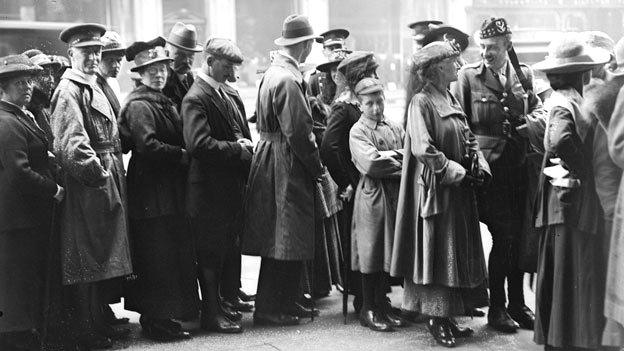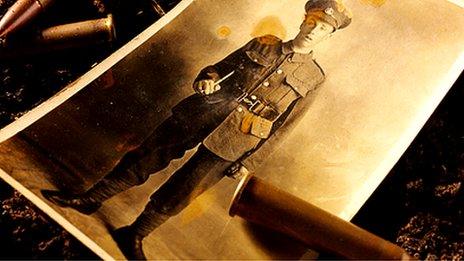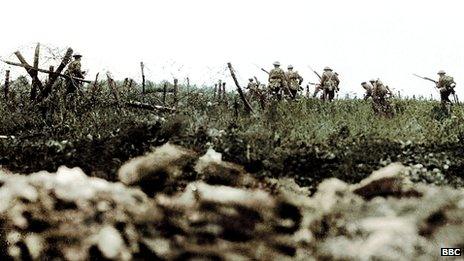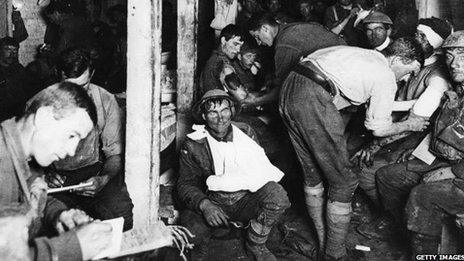Viewpoint: The WW1 film over 20 million people went to see
- Published

Cinema was a young but rapidly growing industry
With 24-hour news people are able to see what is happening in conflicts around the world, whenever they want. But this appetite for the reality of war is nothing new, says Dr Vincent Trott.
In an age of 24-hour news and social media, few of us are entirely ignorant of the brutality of warfare. Harrowing images from war-torn areas can be easily recorded and disseminated with hand-held devices.
Whilst this may be disturbing, we are probably more uncomfortable with the idea that the reality of armed conflict might be hidden from us. Information is now so readily available we have an almost insatiable appetite for the "truth".
Soldiers going into battle, a scene that is believed to have been faked
This appetite, however, is not solely a 21st Century phenomenon. In August 1916 millions of Britons flocked to the cinema to see the latest release. But whereas previous popular films had been fictional romances, dramas or comedies, the film that caught the public imagination was a piece of documentary realism. The Battle of the Somme, a film comprising footage from the front line, brought home the realities of trench warfare in unprecedented fashion.
The cinema at this stage was a very recent invention, but it was already rivalling the music hall and the theatre as the most popular form of entertainment in Britain. Tickets were competitively priced and affordable for most members of society. By 1916, 20 million cinema tickets were being sold each week across the country.
This emerging form of mass entertainment was harnessed to report news from the Western Front. In 1916, six short films were produced which contained images of British soldiers in the trenches.

Trauma and Memory

WW1 traumatised many who survived it, from the soldiers on the front lines to the varied ways in which civilians' lives were affected by it. Explore the issue in a free online course (MOOC) from the BBC and the Open University.

The Battle of the Somme, shot by cameramen Geoffrey Malins and JB McDowell, was the first of a number of full-length films, and by far the most successful.
The Battle of the Somme, a notoriously costly campaign, was still being waged in August 1916, and would not conclude until November. Malins and McDowell began filming in late June, capturing images of the preparation for battle, before filming the infamous first day, 1 July 1916, when over 19,000 British soldiers lost their lives. Filming continued until 10 July, and less than a month later all the footage had been consolidated into a single film, which was first shown on 7 August.
The film was immensely successful, with cinemas struggling to cope with the demand. It's estimated that around 20 million tickets were sold in the first six weeks alone. Even allowing for repeat visits to the cinema, this is a staggering number.
Given the fact the film ran for months after this, it's fair to assume that well over half Britain's population of around 46 million went to see the film.

Battle of the Somme: The unlikely blockbuster

Held British audience record for 60 years, until Star Wars was released
It has been registered in Unesco's Memory of the World Programme
The film was distributed worldwide

The significance of this moment is all too apparent. For the first time, moving images of life on the front line were brought home to a mass audience. Today, we are familiar with footage from far-flung battle zones reaching us at home, but in 1916 this was a novelty. The Battle of the Somme therefore prefigured the mass media coverage of wars that would characterise the late 20th Century.
WW1 was a "total war", which impacted on the entire populations of all the belligerent nations. The development of mass media, which bridged the traditional divisions between the home and the front, is one characteristic of this.
Civilians were now emotionally engaged with the war in a way they hadn't been before. The popularity of The Battle of the Somme also dispels the idea that civilians were at best unaware, or at worst uninterested, in what was going on at the front.
Despite this, the notion of a chasm between naive, jingoistic civilians at home and disillusioned, battle-hardened soldiers in the trenches has become part of the popular memory of the war.
Literature, for example, reinforced this perspective. In his poem Blighters, Siegfried Sassoon expressed his disdain towards the music hall-goers on the home front, claiming bitterly that he'd "like to see a Tank come down the stalls, lurching to rag-time tunes".

The film was shown in expensive cinemas first then cheaper picture houses
Sassoon, of course, may have had a point. The jingoistic sentiments of some civilians would surely have been quelled had they been more aware of the brutal realities of mechanised warfare.
Films like The Battle of the Somme could only do so much. Even today, no amount of footage, however gruesome, can truly replicate first-hand experience.
Critics unanimously praised The Battle of the Somme upon its release, with many highlighting the film's realism. Yet its most famous scene, which depicted soldiers going over the top, is likely to have been faked.
Nevertheless, the huge audience for the film demonstrated the public were far from uninterested with the plight of the troops. They were clearly keen to understand the realities of trench warfare. For all its limitations, The Battle of the Somme provided an insight into the conditions that combatants experienced.

What are MOOCS?

MOOCs stands for massive open online courses and are a new way of learning from the world's leading academics. The BBC is launching four WW1 MOOCs, working with leading universities.
Explore the courses by registering here.

Many deemed the transmission of information between the home and fighting fronts desirable. The British Prime Minister David Lloyd George welcomed the film because it helped to strengthen popular support for the war. Rather than being moved to an anti-war position through their exposure to the realities of the front line, most viewers were further convinced of the need to support the troops in their endeavours.
In later wars governments also sought to use mass media to their advantage. During World War Two, radio further bridged the gap between home and front. When subject to strict government censorship, as the BBC was, it could be a powerful tool for fostering popular support for the war effort.
Yet, the need for censorship highlights the potential drawbacks of media coverage, many of which remain to this day. Successful military operations have always relied on secrecy and the increased flow of information can undermine this.
Many people also find images of suffering to be distasteful or distressing. During WW1, some commentators criticised The Battle of the Somme for exactly these reasons. Despite this, it's clear that many Britons were desperate to know what the troops were going through. Perhaps it was this appetite for "truth" that made The Battle of the Somme so popular.
Find out more about MOOCs and register here. Also, discover more about the World War One Centenary.
Subscribe to the BBC News Magazine's email newsletter to get articles sent to your inbox.